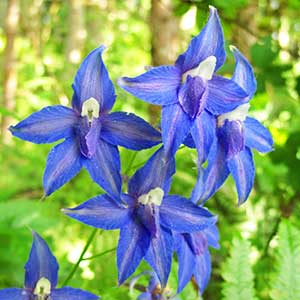Delphinium trolliifolium
Delphinium hutchinsoniae
Columbian larkspur, cow-poison, poison delphinium, poison larkspur
Hutchinson's delphinium, Hutchinson's larkspur, Monterey larkspur
(40-)60-120(-180) cm;
base usually reddish, glabrous to puberulent.
(25-)50-80(-100) cm;
base reddish, not longitudinally ridged, variably puberulent.
blade ± pentagonal, 4-8 × 7-16 cm, margins ± incised, nearly glabrous; ultimate lobes 0-9, width 15-30 mm (basal), 5-20 mm (cauline), widest at middle or in proximal 1/2.
blade round to pentagonal, 1-6 × 1.5-10 cm, puberulent; ultimate lobes 3-17, width 4-16(-25) mm (basal), 1-8(-19) mm (cauline).
(5-)14-40(-75)-flowered, ± open, at least 2 times longer than wide;
pedicel 1-4(-9) cm, puberulent to glabrous;
bracteoles (2-)6-12 mm from flowers, green, linear, 5-9(-14) mm, puberulent.
(2-)7-20(-31)-flowered, open;
pedicel 1-4(-6) cm, puberulent;
bracteoles (2-)8-12 mm from flowers, green, linear, 3-6(-9) mm, puberulent.
sepals dark blue, glabrous, lateral sepals spreading, (8-)14-21 × 5-9 mm, spurs straight or downcurved at apex, within 20° of horizontal, (10-)16-23 mm;
lower petal blades covering stamens, 5-10 mm, clefts 1.5-3 mm;
hairs sparse, mostly near junction of blade and claw, centered or on inner lobes, well dispersed, yellow.
sepals dark bluish purple, puberulent, lateral sepals spreading, (12-)14-19(-24) × 7-12(-15) mm, spurs ascending, decurved apically, 11-19 mm;
lower petal blades slightly elevated, mostly covering stamens, 5-10 mm, cleft 2-3 mm;
hairs sparse, mostly on inner lobes, absent on margins, white.
(15-)23-34 mm, 3.8-5.5 times longer than wide, glabrous.
9-21 mm, 2.5-4.2 times longer than wide, sparsely puberulent.
unwinged;
seed coats smooth.
not echinate, ± smooth to naked eye;
seed coat cells with margins ± undulate, surfaces smooth.
= 16.
Delphinium trolliifolium
Delphinium hutchinsoniae
Delphinium trolliifolium occurs in the northern Coast Range of California, the Columbia River Valley to just east of Mt. Hood, and the Willamette Valley of Oregon upstream to Lane County. California plants differ somewhat from Oregon plants in pubescence patterns and habitat preferences. Further study may show that two entities are involved here.
Hybrids between Delphinium trolliifolium and D. decorum, D. menziesii subsp. pallidum (D. ×pavonaceum Ewan, Peacock larkspur), D. nudicaule, D. nuttallianum, and D. nuttallii are known. Delphinium trolliifolium is likely to be confused only with D. bakeri. Refer to discussion under that species for differences.
(Discussion copyrighted by Flora of North America; reprinted with permission.)
Of conservation concern.
Delphinium hutchinsoniae is known from only a few populations near Monterey and south to the Big Sur region. Hybrids have been produced between D. hutchinsoniae and D. cardinale grown in a common garden. Hybrids also occur with D. parryi subsp. maritimum.
Delphinium hutchinsoniae is similar, and probably closely related, to D. variegatum. The two may be distinguished by the decurved spur of D. hutchinsoniae; the spur of D. variegatum is normally straight (or decurved nearer apex). Delphinium hutchinsoniae lacks marginal hairs on lower petals; such hairs are present in D. variegatum. The two species are also geographically separated.
(Discussion copyrighted by Flora of North America; reprinted with permission.)


